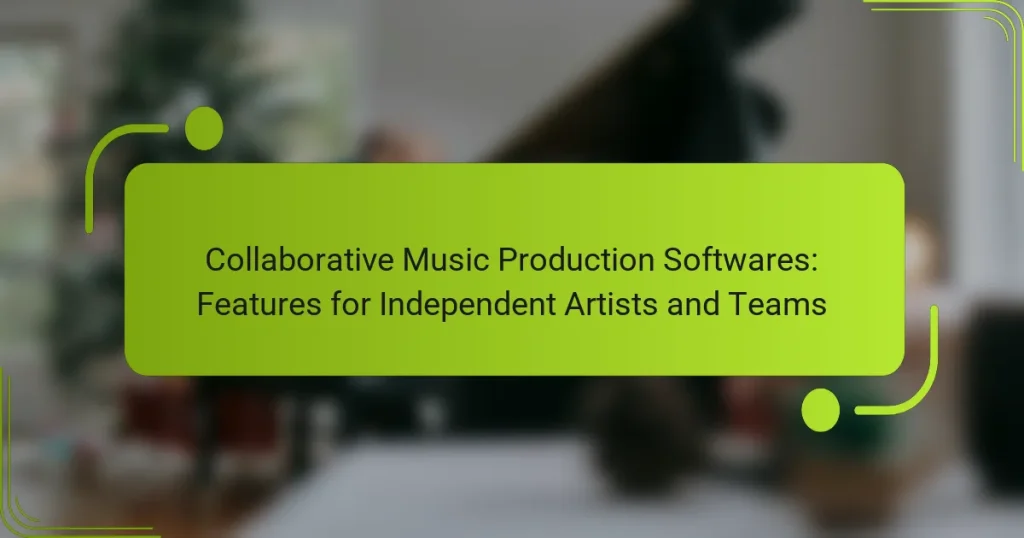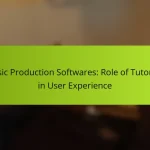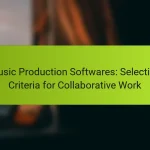Collaborative music production software is essential for independent artists and teams seeking to enhance their creative process. These platforms offer user-friendly interfaces and powerful features that enable seamless teamwork, allowing multiple artists to create, edit, and share music from anywhere in the world. By prioritizing tools that support multi-user access, robust audio and MIDI capabilities, and integrated communication, artists can streamline their collaboration and maximize their creative potential.

What are the best collaborative music production softwares for independent artists?
The best collaborative music production softwares for independent artists combine user-friendly interfaces with powerful features that facilitate teamwork. These tools enable artists to create, edit, and share music seamlessly, regardless of their physical location.
Ableton Live
Ableton Live is a versatile digital audio workstation (DAW) known for its intuitive interface and robust live performance capabilities. It allows multiple users to collaborate in real-time, making it ideal for independent artists looking to create music together from different locations.
Key features include session view for improvisation, a wide range of built-in instruments and effects, and the ability to easily share projects via Ableton Cloud. However, it may have a steeper learning curve for beginners compared to other options.
Logic Pro X
Logic Pro X is a comprehensive DAW exclusive to macOS, offering a rich set of tools for music production. It supports collaboration through features like project sharing and the ability to work on the same project simultaneously using Logic Remote.
Independent artists benefit from its extensive library of sounds and loops, as well as powerful MIDI editing capabilities. However, its high price point may be a consideration for those on a tight budget.
FL Studio
FL Studio is a popular choice among independent artists for its user-friendly interface and flexibility in music creation. It supports collaborative work through cloud storage options, allowing users to share projects easily.
With features like a step sequencer, piano roll, and a variety of plugins, FL Studio caters to different music genres. The lifetime free updates policy is a significant advantage, ensuring users always have the latest features without additional costs.
Pro Tools
Pro Tools is a professional-grade DAW widely used in the music industry, offering advanced features for recording and editing. It supports collaboration through its cloud services, enabling artists to work together on projects from anywhere.
While it provides high-quality audio processing and extensive plugin support, the subscription model can be costly. Independent artists should weigh the benefits of its professional features against their budget and needs.
BandLab
BandLab is a free, cloud-based music production platform that allows independent artists to collaborate easily. It offers a range of tools for recording, mixing, and sharing music, making it accessible for users at all skill levels.
With features like real-time collaboration and a social network for musicians, BandLab fosters community engagement. Its zero-cost model is particularly appealing for independent artists looking to produce music without financial constraints.
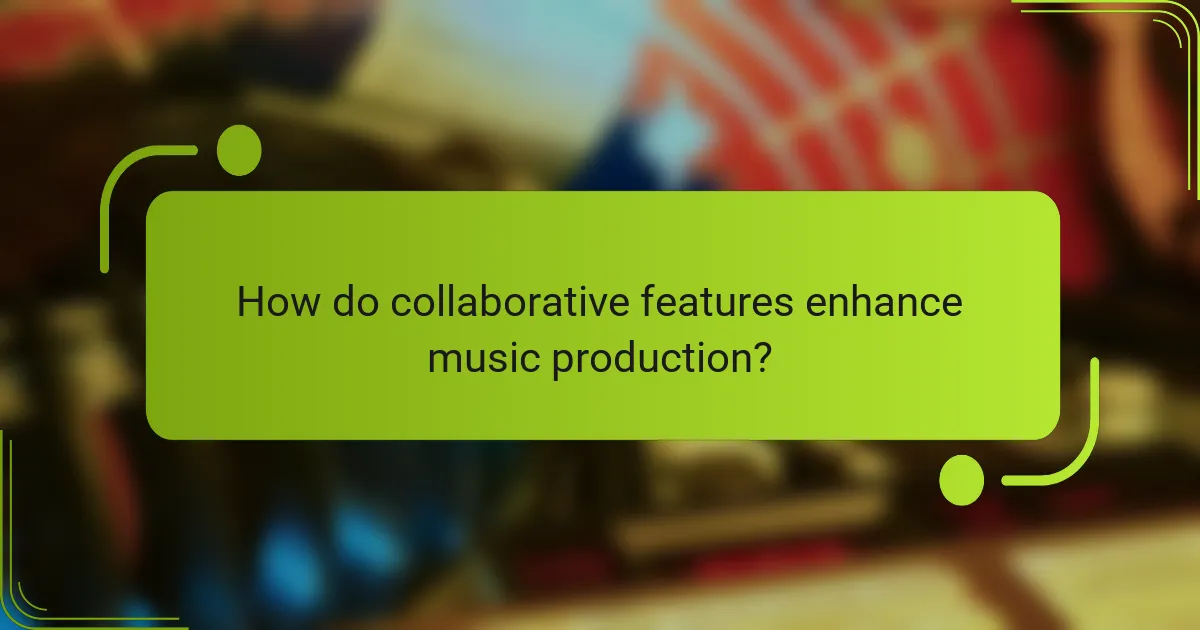
How do collaborative features enhance music production?
Collaborative features significantly improve music production by enabling multiple artists to work together seamlessly, regardless of their physical location. These tools streamline the creative process, allowing for real-time contributions and efficient project management.
Real-time editing
Real-time editing allows multiple users to work on the same project simultaneously, making it easier to share ideas and make instant changes. This feature is particularly beneficial for independent artists and teams who may be in different locations but want to maintain a cohesive workflow.
For effective real-time collaboration, choose software that minimizes latency, ideally keeping it under 20 milliseconds. Popular platforms like Soundtrap and BandLab offer this capability, enabling users to see edits and adjustments as they happen.
Cloud storage integration
Cloud storage integration ensures that all project files are stored online, making them accessible from anywhere with an internet connection. This feature is crucial for independent artists who may need to switch devices or collaborate with team members in different locations.
When selecting a collaborative music production tool, look for options that offer robust cloud storage solutions, such as Google Drive or Dropbox integration. This will facilitate easy file sharing and backup, reducing the risk of data loss.
Version control
Version control helps track changes made to a project, allowing users to revert to previous versions if necessary. This feature is essential for maintaining the integrity of a project, especially when multiple collaborators are involved.
To effectively utilize version control, choose software that automatically saves iterations and allows users to label significant changes. Tools like Avid Pro Tools and Ableton Live provide version history features, making it easy to manage different stages of a project without losing important work.
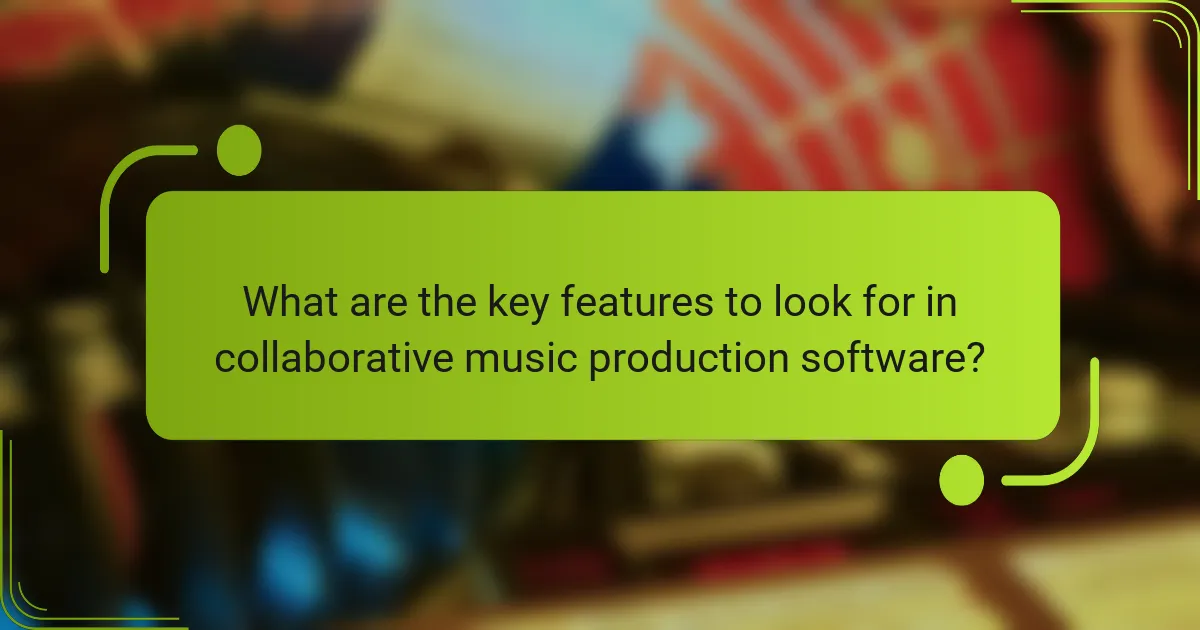
What are the key features to look for in collaborative music production software?
When selecting collaborative music production software, prioritize features that enhance teamwork and streamline the creative process. Key aspects include multi-user access, robust audio and MIDI support, and built-in communication tools to facilitate collaboration among independent artists and teams.
Multi-user access
Multi-user access allows several collaborators to work on a project simultaneously, which is essential for effective teamwork. Look for software that supports real-time editing, enabling users to see changes as they happen. This feature can significantly reduce the time spent on back-and-forth revisions.
Consider platforms that offer flexible user permissions, allowing you to control who can edit, comment, or view specific parts of the project. This ensures that sensitive elements remain secure while still fostering an open collaborative environment.
Audio and MIDI support
Robust audio and MIDI support is crucial for any music production software, as it enables users to work with various sound sources and instruments. Ensure the software can handle multiple audio formats and provides a range of virtual instruments and MIDI capabilities to enhance creativity.
Check for features like low-latency performance and high-quality audio rendering, which are vital for a seamless production experience. Compatibility with popular plugins and VSTs can also expand your creative options and improve workflow efficiency.
Built-in communication tools
Built-in communication tools facilitate direct interaction among collaborators, making it easier to share ideas and feedback. Look for software that includes chat functions, comment sections, or video conferencing capabilities to streamline discussions without needing external applications.
Effective communication features can help clarify artistic visions and resolve issues quickly, reducing misunderstandings. Prioritize platforms that integrate these tools seamlessly into the production environment to maintain focus on the music creation process.

How does pricing vary among collaborative music production tools?
Pricing for collaborative music production tools can vary significantly based on the model chosen, with options ranging from subscription services to one-time purchases. Independent artists and teams should consider their budget, usage frequency, and specific feature needs when evaluating these tools.
Subscription models
Subscription models are popular for collaborative music production tools, offering users access to a range of features for a recurring fee. Monthly or annual subscriptions typically range from around $10 to $50 per month, depending on the tool and the features included.
These models often provide continuous updates and support, making them ideal for teams that need the latest features. However, users should be aware that costs can accumulate over time, so it’s essential to assess long-term value against the subscription price.
One-time purchase options
One-time purchase options allow users to pay a single fee for lifetime access to the software. Prices for these tools can vary widely, typically falling between $100 and $600, depending on the complexity and capabilities of the software.
This model can be cost-effective for independent artists who prefer not to commit to ongoing payments. However, users may miss out on future updates or support unless they pay for upgrades, so it’s crucial to consider the potential need for future enhancements.
Free versions and trials
Many collaborative music production tools offer free versions or trial periods, allowing users to explore features without financial commitment. Free versions may have limited functionality, while trials usually last from a week to a month, providing full access to the software.
These options are excellent for testing tools before making a financial investment. However, users should be mindful of any limitations that may affect their workflow or collaboration, such as restricted file exports or limited storage space.
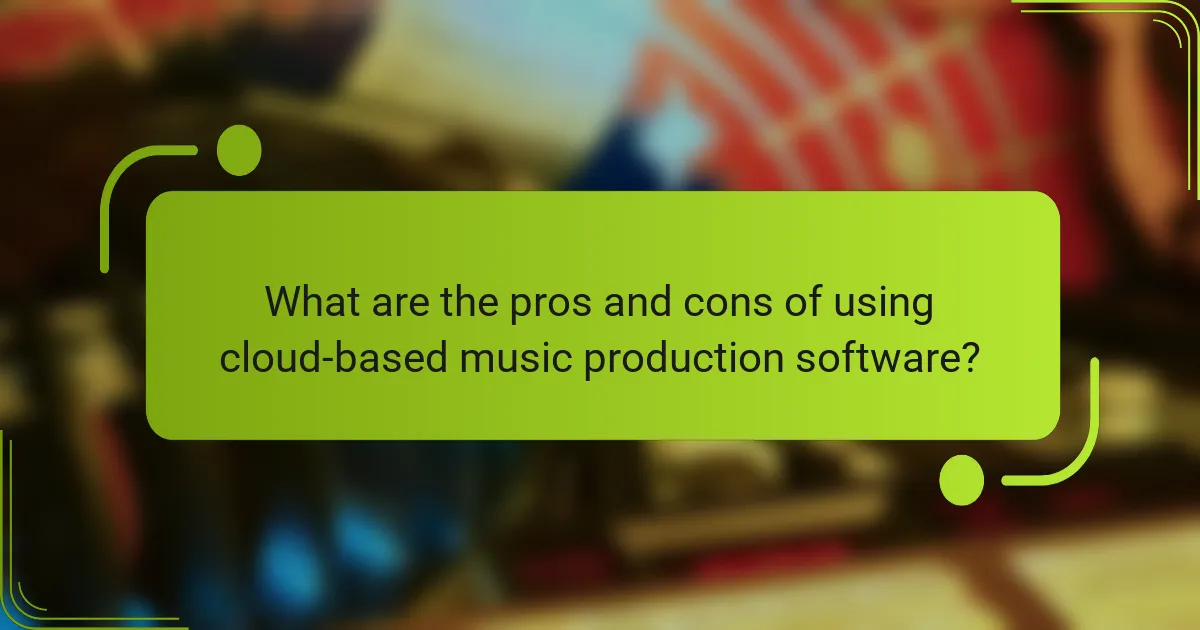
What are the pros and cons of using cloud-based music production software?
Cloud-based music production software offers significant advantages, such as enhanced accessibility and streamlined collaboration, but it also comes with drawbacks like reliance on a stable internet connection. Artists and teams must weigh these factors to determine if cloud solutions align with their creative needs.
Accessibility
Cloud-based music production tools can be accessed from any device with an internet connection, making them highly convenient for independent artists and teams. This flexibility allows users to work on projects from various locations, whether in a studio, at home, or while traveling.
Many platforms are compatible with multiple operating systems, ensuring that artists can collaborate regardless of their preferred devices. This cross-platform functionality can save time and reduce the need for extensive software installations.
Collaboration ease
One of the standout features of cloud-based music production software is its ability to facilitate real-time collaboration. Multiple users can work on the same project simultaneously, making it easy to share ideas and make adjustments instantly.
Tools often include built-in communication features, such as chat or comment sections, which enhance teamwork. This can lead to faster decision-making and a more cohesive creative process, especially for teams spread across different locations.
Internet dependency
While cloud-based software offers many benefits, it is heavily reliant on a stable internet connection. Users may experience disruptions or delays if their connection is slow or unstable, which can hinder the creative flow.
Additionally, some platforms may have limitations on offline access, making it challenging to work without an internet connection. Artists should consider their typical work environments and internet reliability before fully committing to a cloud-based solution.

What are the best practices for independent artists using collaborative software?
Independent artists can maximize their productivity and creativity by following best practices when using collaborative music production software. Key strategies include establishing clear communication, setting defined roles, and utilizing the software’s features effectively.
Setting clear roles
Defining roles within a collaborative project is essential for independent artists to streamline the production process. Each member should have specific responsibilities, such as songwriting, arranging, or mixing, which helps avoid confusion and overlapping tasks.
To implement this, consider creating a simple chart that outlines each person’s role and responsibilities. For instance, one artist might focus on vocals while another handles instrumentation. This clarity can enhance collaboration and ensure that all aspects of the project are covered efficiently.
Regular check-ins can reinforce these roles and allow for adjustments as needed. Encourage team members to communicate their progress and challenges, fostering a supportive environment that keeps everyone aligned and motivated.
